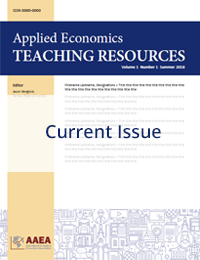Teaching Education Commentary
Adapting to the Nontraditional Classroom: Lessons Learned from Agribusiness and Applied Economics Classes
Erik Hanson(a) and Cheryl Wachenheim(a)
(a)North Dakota State University
JEL Codes: A22, Q00
Keywords: Classroom, distance learning, hybrid-flexible, teaching
First Published Online: December 28, 2020
Volume 2, Issue 5
Abstract
COVID-19 altered instruction in spring 2020 and continues to affect teaching during the 2020–2021 academic year. This commentary reflects the experiences of two instructors of agribusiness and applied economics classes during the recent period of distance education. Strategies and considerations for future instruction are discussed.
References
Anderson, J. 1979. “Teacher Immediacy as a Predictor of Teaching Effectiveness.” Annals of the International Communication
Association 3(1):543–559.
Aultman, L.P. 2006. “An Unexpected Benefit of Formative Student Evaluations.” College Teaching 54(3):251–285.
Boud, D. 2000. “Sustainable Assessment: Rethinking Assessment for the Learning Society.” Studies in Continuing Education
22(2):151–167.
Cameron, B.A., K. Morgan, K.C. Williams, and K.L. Kostelecky. 2009. “Group Projects: Student Perceptions of the Relationship
Between Social Tasks and a Sense of Community in Online Group Work.” The American Journal of Distance Education
23(1):20–33.
Chatterjee, R., and A. Correia. 2020. “Online Students’ Attitudes Toward Collaborative Learning and Sense of Community.”
American Journal of Distance Education 34(1):53–68.
Jayaratne, K.S.U., and G. Moore. 2017. “Perceptions of College Students Toward Online Classes: Implications for Teaching
Online 1.” NACTA Journal 61(4):304–309.
King, S.B. 2014. “Graduate Student Perceptions of the Use of Online Course Tools to Support Engagement.” International
Journal for the Scholarship of Teaching & Learning 8(1):1–18.
Moallem, M. 2015. “The Impact of Synchronous and Asynchronous Communication Tools on Learner Self-Regulation, Social
Presence, Immediacy, Intimacy and Satisfaction in Collaborative Online Learning.” The Online Journal of Distance Education and e-Learning 3(3):55–77.
Osterman, K.F. 2000. “Students’ Need for Belonging in the School Community.” Review of Educational Research 70(3):323–367.
Russo, T., and S. Benson. 2005. “Learning with Invisible Others: Perceptions of Online Presence and Their Relationship to
Cognitive and Affective Learning.” Journal of Educational Technology & Society 8(1):54–62.
Sadler, R. 2002. “Ah! ... So That’s Quality.” In P. Schwartz and G. Webb, eds. Assessment: Case Studies, Experience and Practice
from Higher Education. London: Kogan Page.
Wachenheim, C. 2020. “Remote Learning Environment Provides Unexpected Benefits.” Farm and Ranch Guide, June 5, 2020.
Wilson, J.H., and S.B. Wilson. 2007. “The First Day of Class Affects Student Motivation: An Experimental Study.” Teaching of
Psychology 34(4):226–230.
Zsohar, H., and J.A. Smith. 2008. “Transition from the Classroom to the Web: Successful Strategies for Teaching Online.”
Nursing Education Perspectives 29(1):23–28.
Articles in this issue
So You Want to Run a Classroom Experiment Online? The Good, the Bad, and the Different
Stephen N. Morgan, Misti D. Sharp, and Kelly A. Grogan
No Honor Among Cheaters: A Prisoners Dilemma Approach to Reduce Cheating in Online Classes
Jeffrey S. Young
Insights from Asynchronous Lecture Viewing Behavior
Michael Black
Adapting to the Nontraditional Classroom: Lessons Learned from Agribusiness and Applied Economics Classes
Erik Hanson and Cheryl Wachenheim
Reflections in Adjusting to a Global Pandemic from a Regional Agribusiness Program
J. Ross Pruitt, Rachna Tewari, and Joseph E. Mehlhorn
Considerations for Economic Instruction in the Era of COVID-19
Thomas P. Zacharias and Keith J. Collins


